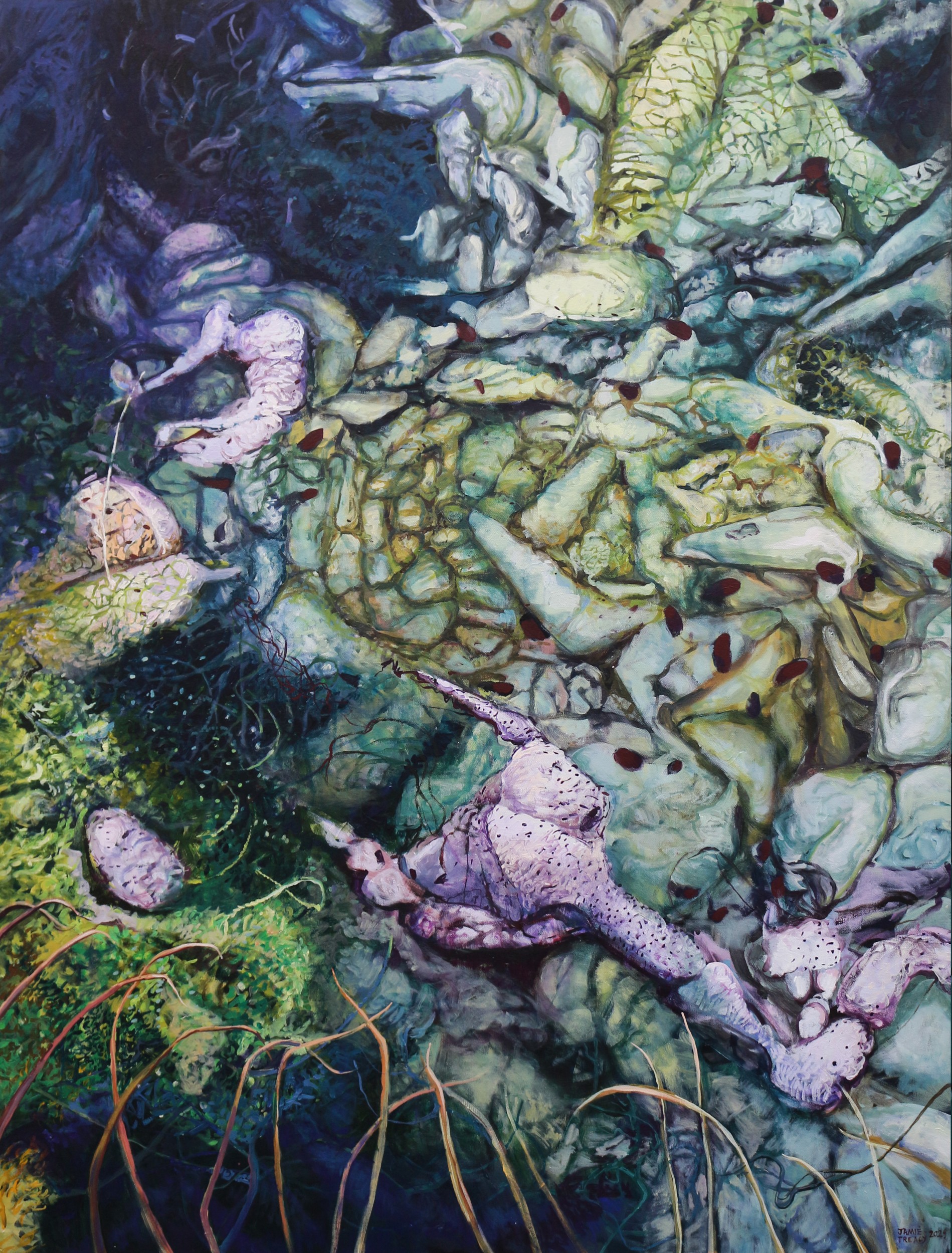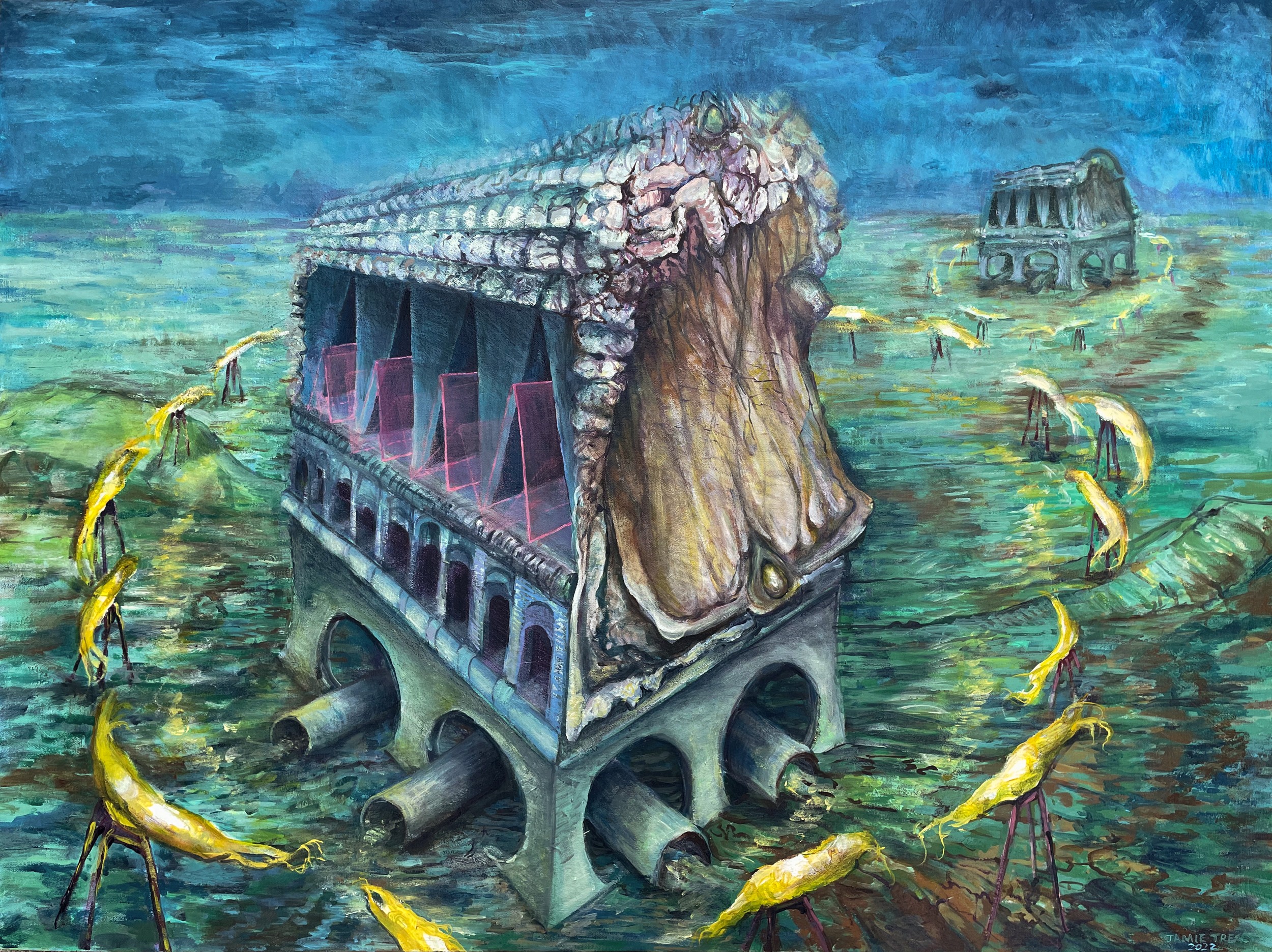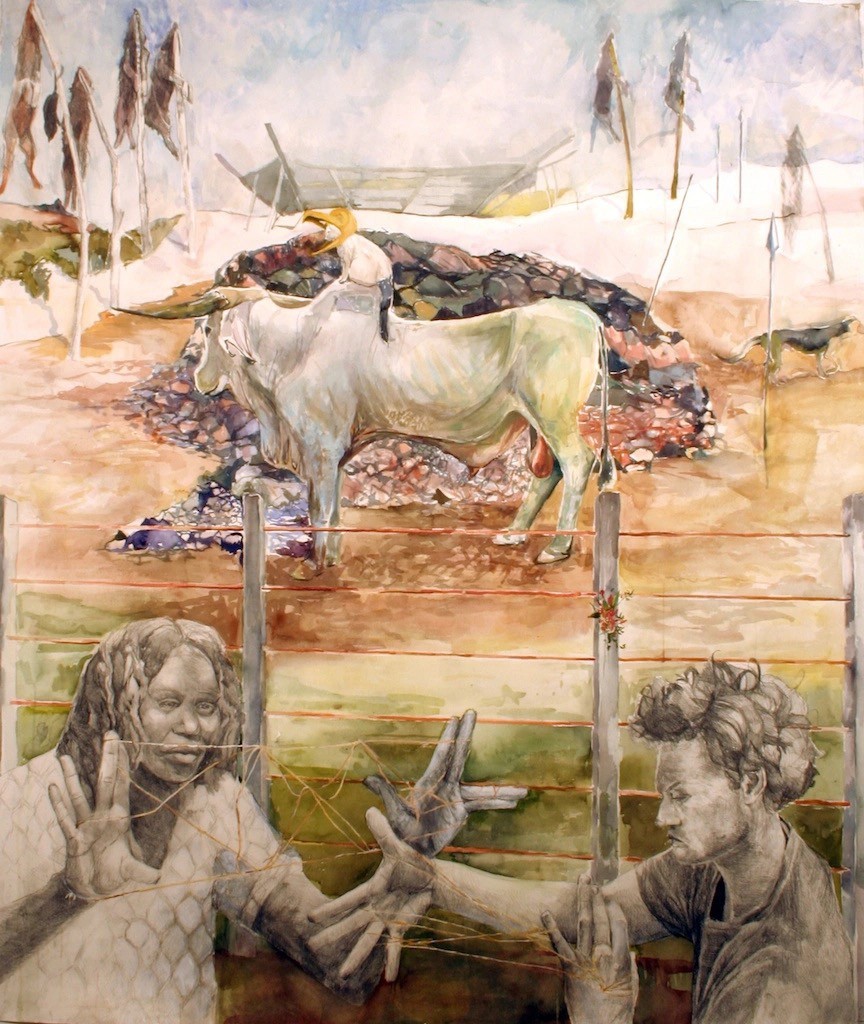Alright – so today we’ve got the honor of introducing you to Jamie Treacy. We think you’ll enjoy our conversation, we’ve shared it below.
Alright, Jamie thanks for taking the time to share your stories and insights with us today. Learning the craft is often a unique journey from every creative – we’d love to hear about your journey and if knowing what you know now, you would have done anything differently to speed up the learning process.
In learning the craft of painting, understanding color is the hook that never lets me go. I love that the act of mixing and applying paint offers so many possibilities, and a lifetime of fascination is laid out before me. In my freshman year in the painting program at the University of Michigan School of Art and Design, color was doled out one at a time in our introductory painting course. I remember we painted for weeks with only black paint, then finally added white, then burnt sienna. To counter the stifling of the limited palettes I used during class, I loved staying in the paint studio late into the night to experiment with more garish hues.
One night in the painting studio, I walked out into the hall and saw that a fellow painting student had painted a single cinder block of the hallway wall lemon yellow. I was tickled by her boldness, but I also felt like her color intervention on the bland wall was incomplete. In my caffeine-fueled state, I added to her yellow cinder block from my own palette and painted three adjoining blocks: one peach, one moss green, one turquoise. Now we had a color scheme that told a little story to those who passed. I took the last bus home that night around 2am, not seeing myself as a vandal but quite thrilled at my participation in this nocturnal embellishment of our school.
When I returned to the art school the next day for my next class, there was a note from the administration taped to the wall next to our little color-field piece. The note said something about how disappointed they were in whoever did this, and implied that it was a grave violation. I was surprised and confused by this anonymous chastisement from the administration… After all, we were in a paint studio that was blanketed by years of dribbles, smears and spills! Oh, but the guilt I felt was immense. In that sense the chastisement was wholly effective!
To add to my confusion, I ran into the painter of the lemon yellow block (more of a conceptual-minimalist than myself). She instantly knew it was me who had ruined the solitary power of her yellow intervention on the industrial white wall. She scolded me at my color choices, and implied that her concept was over my head. Feeling baffled and a little guilty that I had participated in defacing university property; I lingered at the studio again that evening and used my gesso to paint over the colored blocks and returned it to a version of white.
Reflecting on this odd moment in my art studies, what stands out as the lesson is that the wielding and control of color is a powerful thing. As I have developed my craft, color has been a key linking element in my bodies of work. I often experiment with a color palette over several paintings, exploring odd relationships and poking at the tensions they create.


Awesome – so before we get into the rest of our questions, can you briefly introduce yourself to our readers.
I am a visual artist working in painting, drawing and mixed media. Junior year of high school is when I mark the start of my art career… I decided art was my reason for being on earth. In my undergraduate study at the University of Michigan, I developed a painting and drawing style that was steeped in expressionism–bold brushwork, bold color, bold content. In my 20’s, I created narrative paintings, often with myself as the main character. Looking back, I think my scores of self-portraits helped me work through how I wanted to present myself to the world. I was able to try on representations of manhood, of queerness and explore real and fictional relationships. It was interesting to watch peoples’ reactions to the “me” in my paintings, without having to experience their reaction to me in the flesh. Maybe it was practice for showing up as my authentic self. As my work shifted more into cityscapes and landscapes, the figures became smaller and part of the scene. I began exhibiting in Detroit, Michigan; showing in alternative spaces and artist-run galleries. I loved painting the decaying buildings in Detroit; imagining their complex histories. I was interested in capturing the feeling of a place.
In 2004, I moved to Oakland, California to pursue a Masters of Fine Arts in painting and drawing at California College of the Arts. I was enthralled to live near the ocean and the hills and it showed up everywhere in my work. I drew imagery from my hikes in the Oakland Hills and my open water swims in the SF Bay. I often would paint things like spider webs, lichen and piles of kelp in larger than life scale. My study of local ecosystems has continued in my current work. Sometimes working from tiny corners of my urban backyard as a reference, I’m interested in enlarging and even exalting the easily overlooked in nature.
I am really proud of how my body of work has grown over the past twenty years. Since grad school, I have pushed myself to explore the evocative power in painting. In my current work, even though I’m not painting people, our inner worlds are my driving inspiration. I’m fascinated how a painting can be used as a third point in a conversation; and how abstraction can be a visual language for that which is hard to describe. In my current series, I’m switching back and forth from working from a real reference and working from my imagination. My practice of close observation through painting and drawing has helped me form a mental model of the organic (and sometimes mechanical) forms that surround me. I’m able to pull from the mental model of the forest’s forms and the city’s infrastructure, and then improvise new and imagined spaces.
I create paintings because I have a curiosity to know myself. My hope is that the finished product is an emotional anchorpoint for the viewer, and an invitation to know themselves. Oftentimes I create titles that invoke the viewer’s participation in the scene. For example, my recent painting titled As We Watched the Lake Evolve welcomes the viewer to my side as we study the strange happenings at the edge of the lake. I find comfort in the imagined companionship of viewing something strange with a friend and stumbling over our words together as we try to describe what we saw.


Can you share a story from your journey that illustrates your resilience?
Moving from Michigan to California for my graduate program at California College of the Arts was a huge feat. Tackling imposter syndrome, having panic attacks in the financial aid office and adapting to the cost of living in moving to Oakland from Detroit were experiences that had me questioning my choices more than once. My all too common impoverished student state left me pretty traumatized, and I knew I did not want to be a starving artist with an MFA. I had enough artist mentors in my life that I understood I would need to supplement my art career somehow, and teaching always felt like a logical fit.
While at CCA, I worked as a teaching artist at Berkeley High School, and it ended up being the start of a wonderful and challenging career teaching visual art in high schools in the Bay Area for 18 years. About two years ago, I made the shift to working with teachers as an instructional coach in the arts. I feel so fortunate working in art education, and I’m incredibly proud that I’ve been able to balance it alongside my art career. When my art world and education worlds collide, people often can’t believe that I’ve maintained both for so long.
I was hesitant to mention my art education life in this profile; after all this is about my art, not my teaching! The resilience story comes from how I’ve learned to preserve my energy and creativity while giving a lot to others during the day. I’ve developed an exercise I call “The Mental Fortress” (I’ve actually done a painting of this fictional fortress!) During the school day, I start to decide what energy I’m going to allow into my fortress, and what I’m going to keep out. I decide the parts of my mind and my energy that I will keep protected inside of that fortress. The Mental Fortress is the place I protect and nurture my childhood joy of creating. In this multi-roomed edifice, sometimes I occupy its smallest rooms–the nights when there’s not much energy for painting. I might just go into the studio, look at my work for a little while, rearrange the work on the ledge and then feel worn out. But over the past few years, the large ballrooms and halls of my mental fortress have welcomed me in.
I’m resilient because I have realized that I have a lot to give others, but not everything to give. Creative energy is worth preserving! My Mental Fortress helps me hold to the bravery, the playfulness and the joy of being an artist.


What’s a lesson you had to unlearn and what’s the backstory?
I’ve had to learn to let go of the narrative of feeling “behind” in my artistic development. I grew up as a competitive swimmer, and that sense of discipline and willingness to challenge myself has helped me immensely… but my competitive nature has not always served me well in my art career. I would take rejections as a judgment on my worth as an artist (and a person), and I would compare myself to artists that I perceived to have more success. I really was hard on myself!
I’ve learned now to give myself a lot more grace. It’s taken me years to stand by my work as an artist, and know that it is powerful and worthy of being viewed. The inner critic is so fierce in me. If it goes unchecked, I’ll run myself harder than a cruel overlord. I’m working on being kind and patient with myself, and I’m trying to enjoy slowing down. There are times when being an artist feels like a punishing labor (like when I’m building frames!) In unlearning my old ways, I try to recenter myself in the joy of being an artist and that I’m exactly where I’m supposed to be in my career. I’m not behind after all.


Contact Info:
- Website: http://jamietreacy.com/
- Instagram: https://www.instagram.com/jamietreacy/
- Facebook: https://www.facebook.com/jamie.treacy1/
- Linkedin: https://www.linkedin.com/in/jamietreacy/
Image Credits
All artwork photos by Jamie Treacy Profile photo by Jonathan Botkin


